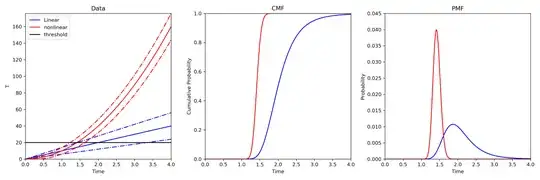So, after thinking this my own question over, I have come up with the following solution. I first list the steps I took, the output figure, and the python code I used to generate that figure. I look forward to anyone's feedback on whether this is a legitimate method for solving the problem.
Steps:
- Calculate $T(t)$ for linear and nonlinear models.
- Calculate the probability that the model is above the threshold at every time step. This provides the cumulative mass function for whether the model has crossed the threshold.
- Calculate the probability mass function from the CMF.
Figure:
 Code:
Code:
import numpy as np
import matplotlib.pyplot as plt
import scipy.stats
# set time domain
t0 = 0
tf = 4
ts = 0.01
tnum = int((tf-t0)/ts+1)
t = np.linspace(t0, tf, tnum, endpoint=True)
# params
k = 10
c = 4
threshold = 20
# linear function
T_linear = np.zeros(tnum)
T_linear_h = np.zeros(tnum)
T_linear_l = np.zeros(tnum)
T_linear = k*t
T_linear_h = k*t+c*t
T_linear_l = k*t-c*t
# nonlinear function
T_nlinear = np.zeros(tnum)
T_nlinear_h = np.zeros(tnum)
T_nlinear_l = np.zeros(tnum)
T_nlinear = k*t**2
T_nlinear_h = k*t**2+c*t
T_nlinear_l = k*t**2-c*t
# compute cdf
cdf_linear = np.zeros(tnum)
cdf_nlinear = np.zeros(tnum)
for i in range(tnum):
iL_mu = T_linear[i]
iL_sig = (T_linear_h[i]-T_linear[i])/2
inL_mu = T_nlinear[i]
inL_sig = (T_nlinear_h[i]-T_nlinear[i])/2
cdf_linear[i]=1-scipy.stats.norm(iL_mu, iL_sig).cdf(threshold)
cdf_nlinear[i]=1-scipy.stats.norm(inL_mu, inL_sig).cdf(threshold)
# compute pmf
pmf_linear = np.zeros(tnum)
pmf_linear[0] = cdf_linear[0]
pmf_nlinear = np.zeros(tnum)
pmf_nlinear[0] = cdf_nlinear[0]
for i in range(1,tnum):
pmf_linear[i] = cdf_linear[i]-cdf_linear[i-1]
pmf_nlinear[i] = cdf_nlinear[i]-cdf_nlinear[i-1]
# visualize functions
fig = plt.figure(figsize=[15,5])
ax1 = fig.add_subplot(1,3,1)
ax1.plot(t,T_linear, 'b', label='Linear')
ax1.plot(t,T_linear_h, 'b-.')
ax1.plot(t,T_linear_l, 'b-.')
ax1.plot(t,T_nlinear, 'r', label='nonlinear')
ax1.plot(t,T_nlinear_h, 'r-.')
ax1.plot(t,T_nlinear_l, 'r-.')
ax1.axhline(threshold, color='k', label='threshold')
ax1.set_xlim([t0,tf])
ax1.set_ylim([0, np.max(T_nlinear_h)])
ax1.set_xlabel('Time')
ax1.set_ylabel('T')
ax1.set_title('Data')
ax1.legend()
# visualize cdf
ax2 = fig.add_subplot(1,3,2)
ax2.plot(t,cdf_linear, 'b')
ax2.plot(t,cdf_nlinear, 'r')
ax2.set_xlim([t0,tf])
ax2.set_ylim([0, 1])
ax2.set_xlabel('Time')
ax2.set_ylabel('Cumulative Probability')
ax2.set_title('CMF')
# visualize pmf
ax3 = fig.add_subplot(1,3,3)
ax3.plot(t,pmf_linear, 'b')
ax3.plot(t,pmf_nlinear, 'r')
ax3.set_xlim([0,4])
ax3.set_ylim([0, 0.045])
ax3.set_xlabel('Time')
ax3.set_ylabel('Probability')
ax3.set_title('PMF')
fig.tight_layout()
